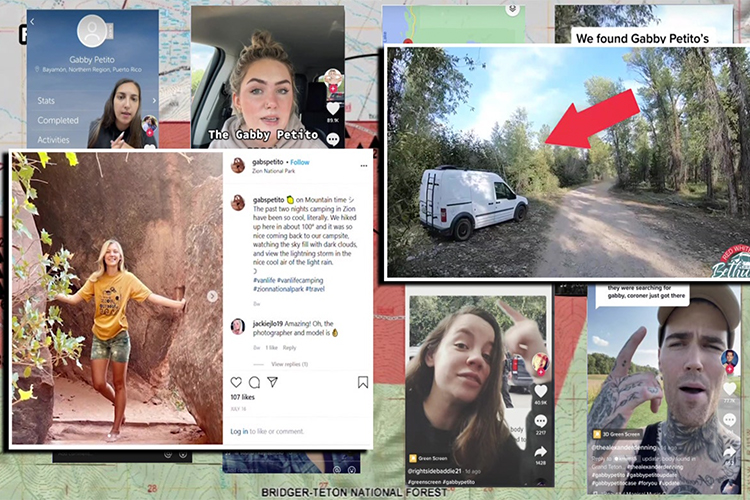
Digital Sleuths use their platforms in order to investigate all the ins and outs of Gabby Petito’s disappearance. photo courtesy of Fox 13
The news of Gabby Petito’s disappearance has taken the media by storm, creating mass controversy.
Any avid social media user has most likely heard the name “Gabby Petito.” Petito has gripped the internet for weeks after the report of her disappearance on September 11, 2021.
Petito, 22, and her 23-year-old fiance, Brian Laundrie, are travel vloggers of “the Nomadic Statik.” Petito and Laundrie would document their cross-country trips on their YouTube channel and had a relatively large following of their adventures in Petito’s van. So after hearing that Laundrie had returned home in Petito’s van without her, Petito’s name was inescapable.
Her disappearance has gotten an enormous amount of attention, unlike anything seen before. True crime fans on Tik Tok, Twitter, and Youtube have spent the past month meticulously dissecting each of Petito’s videos and Instagram posts. Individuals noticed differences in posts and her verbiage; some went to find her missing van. Thousands of people boosted their social media presence by making in-depth informational videos for everyone to watch.
Out of the thousands of missing reports filed daily, why has this one captured the eyes and ears of America? For many, this case has become very personal following released police body camera footage showing a distressed Petito and a cool, calm, and collected Laundrie after being reported for domestic abuse. Many have been able to resonate with Petito’s circumstances, some empathize with her parents, and others are just fascinated that there is a true crime episode unfolding in front of their eyes.
The media has granted people the ability to follow along with the investigative process every step of the way. For example, on October 12th, 2021, the Teton County Coroner’s Office held a press conference discussing the verdict made by local law enforcement with assistance from the Federal Bureau of Investigation: “In the manner of death of Gabrielle Venora Petito, we find the cause and manner to be: cause, death by strangulation, and manner is homicide,” according to the Coroner’s Office. In minutes, social media was flooded with prayers, angry tweets, and discussions on how to find the still missing Laundrie.
As incoming news of Petito’s case fizzled out, people on social media began to point out that this is a prime example of the “Missing White Woman Syndrome.” Famous journalist Gwen Ifill coined the term in 2004 at the Journalists of Color Conference. The Missing White Woman Syndrome refers to the disproportionate media coverage given to white women versus people of color. Ifill said at the conference, “If there’s a missing white woman, we are going to cover that every day,” referring to her and other journalists in her field. Ifill’s explanation can be seen countless times throughout the media, in all different types of news coverage outlets.
In Wyoming, where Petito was said to be last seen, over 710 Indigenous people disappeared between 2011 and 2020. About 20% of those cases were still unsolved after a month, which is almost double the rate in the white population, according to a state report released in January. The report also found that “One-fifth of the Indigenous people reported missing were missing for 30 or more days, which is a higher percentage than White people missing for 30 or more days (11%).” They also reported that only 30% of indigenous women in Wyoming had any media coverage, compared to 51% of white women in Wyoming. These are alarming findings, as over 710 Indigenous people have disappeared in the last ten years, yet Gabby Petito is the name that has been spread nationwide in under a month.
Shana Saint-Phard, the President of TJ’s Black Student Alliance, agrees with the countless people online that this is a case of the Missing White Woman Syndrome, “Oh, one hundred percent, it’s one example of many… it’s just a repetition of how people of color are treated in society.” This case has highlighted many of the foundational issues in our society. She pointed out the difference in how society and law enforcement treat people of color versus white people. Saint-Phard discussed that white women are seen as what law enforcement is supposed to protect, but “that same level of protection is not provided for women of color, let alone male people of color who are actually targeted by law enforcement.”
When people go on social media, they want to produce and consume what makes them feel comfortable. When media consumers see something that confirms the subconscious prejudices they may have, they are more likely to retain and build on that prejudice. “Media does a really good job of confirming our biases because it’s what we expect, and we are really comfortable with what we expect. So the media really feeds off of those same ideas,” explained Saint-Phard. “I feel like this case specifically is a representation of us having those confirmation biases.” Consuming and producing things that are in one’s comfort zone can lead to the disproportionate coverage of people, which Saint-Phard and thousands of others online seem to be trying to point out.
The question is, how do we respect a case like this while also making sure that other cases with people of color are prioritized the same? “I think it truly is the media’s duty to counteract what they’ve done in the past and make sure that we’re seeing black women in the same light,” Saint-Phard explains. “It’s not to say that her case isn’t absolutely tragic, it is, but the fact that you will never hear about a woman of color going missing despite being more likely, statistically, to be targeted or go missing.” Petito’s case sparked a massive discussion of the ingrained racism and the bias littering the media. The only question is: will anything change?